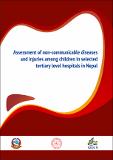Please use this identifier to cite or link to this item:
https://hdl.handle.net/20.500.14356/2245| Title: | Assessment of non-communicable diseases and injuries among children in selected tertiary level hospitals in Nepal |
| Other Titles: | Final report (2021-2022) |
| Authors: | NHRC |
| Citation: | Report Assessment of non-communicable diseases and injuries among children in selected tertiary level hospitals in Nepal: Kathmandu: Nepal Health Research Council |
| Issue Date: | 2023 |
| Publisher: | Nepal Health Research Council (NHRC) |
| Keywords: | Non-communicable diseases Injuries Children Hospital Nepal |
| Abstract: | Background: The burden of non-communicable diseases (NCDs), including hypertension, cancer, and diabetes mellitus is increasing in people living in low- and middle-income countries (LMICs). As NCDs are emerging into one of the major public health problems, exploring the disease burden among children is key to decision-making and planning processes. There is limited data on causes and trends of admission and mortality among children admitted to pediatric wards in the hospitals of Nepal. This study aimed to identify the most common non-communicable diseases and injuries (NCDI) in children from key pediatric hospitals and tertiary level hospitals in Nepal. Methods: A health facility-based cross-sectional study was conducted from June to September 2021 using secondary data collected by medical record departments in 15 tertiary level hospitals in Nepal using purposive sampling. Both qualitative and quantitative methods were employed. This retrospective study captured data over five consecutive years (Fiscal Year (FY) 2072/73 to 2076/77). Data are expressed in percentages and proportions. Qualitative data is analyzed using thematic analysis. Result: Over the FYs 2072/73 to 2076/2077, emergency room and hospital admission records in the study hospitals demonstrated that digestive disease (24.8% in admitted and 29.5% in emergency) neurological disorders (21.4% in admitted and 23.8% in emergency) and chronic respiratory diseases (14.2% in admitted and 12.7% in emergency) were the most prevalent (level 2) types of childhood NCD. Similarly, unintentional injuries (41.9% in admitted and 45.7% in emergency), transport injuries (31.6% in admitted and 21.7% in emergency) and uncategorized injuries (18.5% in admitted and 25.2% in emergency) were the most prevalent injuries among children. Paralytic ileus and intestinal obstruction (20.9% in admitted and 26.6% in emergency), other neurological disorders (21.4% in admitted and 23.8% in emergency) and asthma (14.2% in admitted and 12.7% in emergency) were the leading (level 3) causes of hospital visits. Among injuries (level 3), road injuries (31.6% in admitted and 21.7% in emergency), falls (21.1 % in admitted and 22.8% in emergency) and uncategorized injuries (18.5% in admitted and 25.2% in emergency) were the leading causes of hospital visits. Neurological disorder (13.7%) and other non-communicable disease (46.6%) were the most common cause of NCD related death. Unintentional injuries (47.4%) were the commonest cause of injuries related death. Conclusion: The present assessment revealed that NCDIs are common among children and adolescents (0-18years) in Nepal. There is an urgent need to strengthen the health system to work towards prevention and management of childhood NCDI. Tertiary level health facilities need to improve and enhance infrastructure and train health care workers to be better prepared for such admissions. |
| Description: | Research Report |
| URI: | https://hdl.handle.net/20.500.14356/2245 |
| Appears in Collections: | NHRC Research Report |
Files in This Item:
| File | Description | Size | Format | |
|---|---|---|---|---|
| Childhood-NCDI-report.pdf | Download Full text Report. | 8.03 MB | Adobe PDF |  View/Open |
Items in DSpace are protected by copyright, with all rights reserved, unless otherwise indicated.
